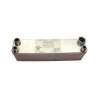- Joined
- Jul 5, 2016
- Messages
- 18
- Reaction score
- 2
- Points
- 3
Hello everyone,
Would anyone know how's best to adjust the amount of hops in a recipe between leaf/pellet? I'm of the understanding less weight of hops would be needed for both bittering and aroma in the case of pellets, as the pellets would dissolve in the beer, whereas leaf hops would be removed post-boil?
I'm asking because most suppliers near me (Manchester, UK) sell a lot of foil-wrapped leaf hops rather than pellets. I'm also weighing up the arguments in terms of cost and storage.
Thanks in advance.
Would anyone know how's best to adjust the amount of hops in a recipe between leaf/pellet? I'm of the understanding less weight of hops would be needed for both bittering and aroma in the case of pellets, as the pellets would dissolve in the beer, whereas leaf hops would be removed post-boil?
I'm asking because most suppliers near me (Manchester, UK) sell a lot of foil-wrapped leaf hops rather than pellets. I'm also weighing up the arguments in terms of cost and storage.
Thanks in advance.











